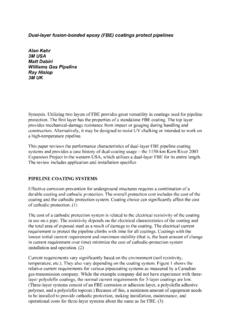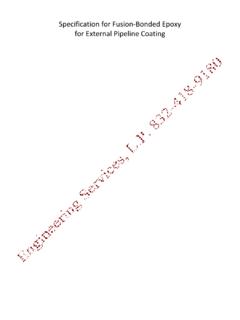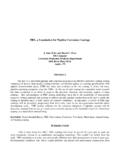Transcription of Study of cathodic protection shielding under coating ...
1 Corrosion Science 99 (2015) 249 257 Contents lists available at ScienceDirectCorrosion Sciencej ourna l h omepage: of cathodic protection shielding under coating disbondment onpipelinesDa Kuang, Y. Frank Cheng Department of Mechanical & Manufacturing Engineering, University of Calgary, Calgary, Alberta T2N 1N4, Canadaa r t i c l e i n f oArticle history:Received 7 May 2015 Received in revised form 27 June 2015 Accepted 27 July 2015 Available online 29 July 2015 Keywords:A. SteelB. PotentiostaticC. cathodic protectionC. Polymer coatingsa b s t r a c tIn this work, the cathodic protection (CP) shielding behavior of pipeline coatings, , high densitypolyethylene (HDPE) and fusion bonded epoxy (FBE), was investigated. While the HDPE is a CP-shieldingcoating, the FBE is permeable to CP. The structure of HDPE does not change upon CP permeating test, andwater molecules are not absorbed into the coating .
2 Conversely, there are obvious changes of the func-tional groups in FBE. Water uptakes into the coating occur continuously with time. The CP permeationthrough FBE coating is time dependent. A more negative CP potential level enhances the CP permeation. 2015 Elsevier Ltd. All rights IntroductionPipelines are protected from external corrosion by both coat-ing and cathodic protection (CP). While the coating provides the rst line of protective barrier, CP serves as a backup to preventcorrosion attack either at coating faults such as pinholes andholidays or under coating disbondment [1 5]. However, pipelinecorrosion and corrosion induced cracking have been widely doc-umented [6 8]. When coating is disbonded at small faults, suchas pinholes or holidays, CP current can be shielded, either fully orpartially, to reach the disbonding crevice, especially at the crevicebottom.
3 As a result, the CP could not protect the area that is ina corrosive environment. This is called CP shielding . Anotherscenario encountered in reality to cause CP shielding is the dis-bondment of a defect-free coating due to either an inadequatecoating application process or the lost adhesion of the coating tothe steel substrate during service. For example, spirally wrappedtape coatings can experience disbonding over pipeline welds. Inthis situation, the CP shielding is attributed to the coating property[9,10]. It has been reported [11] that up to 85% of all the exter-nal corrosion of pipelines is under disbonded CP shielding coatings are those which do not prevent distributionof CP current to the steel substrate through the disbonded coating [12]. Corresponding author. Fax: +1 403 282 address: ( Cheng).
4 It is generally accepted [13] that the widely used fusion bondedepoxy (FBE) and coal-tar enamel coatings exhibits evidence ofpassage for CP current, while the high performance compositecoating and polyethylene tape block CP current in long-term tests[13]. There have been works to measure and model environmentalchemistry and electrochemistry of the electrolyte trapped underCP shielding or non- shielding coatings [14 17]. Moreover, lab testshave been conducted attempting to understand the CP shieldingbehavior of some pipeline coatings through electrochemical mea-surements, including potentiostatic current and electrochemicalimpedance spectroscopy [18 20]. However, the majority of thetesting did not duplicate the reality of pipeline corrosion under dis-bonded coating in the eld. For example, the solution pH trappedunder the disbonded coating was generally measured ex-situ bysampling small amount of electrolyte [21 23].
5 In this work, a test rig was designed and constructed tosimulate disbondment of defect-free coatings on pipelines encoun-tered in reality. The pH of the electrolyte under disbondedcoating was monitored in-situ by a micro pH meter which wasinstalled into the disbondment crevice. Two pipeline coatings, , FBE and high-density polyethylene (HDPE), were used inthis work. Measurements of potential and potentiostatic current,optical characterization, and Fourier transform-infrared spec-troscopy (FT-IR) were combined to Study the mechanistic aspectsassociated with the compatibility of coatings with cathodic 2015 Elsevier Ltd. All rights D. Kuang, Cheng / Corrosion Science 99 (2015) 249 257 Fig. 1. Schematic diagram of the experimental setup to measure the permeability of coatings to CP, where WE and RE refer to working electrode and reference electrode, Coatings, steel and solutionThe FBE and HDPE membranes, with a thickness of 250 m and850 m, respectively, were used in this work.
6 All coating mem-branes, supplied by Bredero Shaw, were cut into circular shape witha diameter of 5 steel used in this work was X65 pipeline steel, with a chem-ical composition ( ): C , Si , Mn , P , S ,Mo and Fe balance. The steel coupons were sealed with LECO epoxy, leaving a working area of 1 cm2. Prior to test, the electrodewas subsequently ground with 400, 800, 1000 and 1200 grit sandpapers, and cleaned in distilled water and diluted bicarbonate solution, , M NaHCO3, was used tosimulate the ground water. It was made from analytic grade reagentand ultra-pure water, with a pH of All tests were conducted at23 Measurements of CP permeability of coatingsA test rig was home-designed and constructed for testing of theCP permeability of coatings, as shown in Fig. 1, where two testchambers were separated by a coating membrane.
7 This setup wasto measure the compatibility of defect-free coatings with CP. A car-bon rod was placed in the top chamber and used as the auxiliaryanode. The steel electrode was installed in the bottom CP potentials of V(copper/copper sulphate, CSE) and V(CSE) were applied, respectively, through an external directcurrent power supply. A gap between the steel electrode and thecoating was created to simulate a disbondment crevice, which mm in height. A Loctite-495 instant adhesive was used to sealthe coating with the two cylindrical measurements were conducted using aSolartron 1280C system, where a platinum sheet and a saturatedcalomel electrode (SCE), which was installed in the top chamberin Fig. 1, were used as counter electrode and reference electrode,respectively, and the steel electrode installed in the bottom cham-ber was used as working electrode.
8 Both chambers contained theprepared M NaHCO3solution. The potential of the steel elec-trode and the potentiostatic current between working electrodeand counter electrode under CP application were measured. More-over, an Orion 9810BN micro pH electrode was installed in thedisbondment between the coating membrane and steel electrodeto monitor the solution testing, the morphology of the steel electrode wasobserved by an optical coating characterizationThe coating samples were characterized by FT-IR with a NicoletiS10 Spectrometer. For all the spectra recorded, the samples under -went a 64-scan data accumulation in the range of 500 5500 cm 1at a spectra resolution of cm Morphological observation of steel electrodesFig. 2 shows the optical morphology of the steel electrode M NaHCO3solution trapped under the disbonded HDPE coat-ing after various times of testing at an applied CP potential of V(CSE).
9 It is seen that the steel experiences serious corrosionafter 5 days of testing. With the increase of the testing time, morecorrosion products are generated and deposited on the steel sur-face. Obviously, the applied CP cannot provide effective protectionto the steel under disbonded HDPE 3 shows the optical morphology of the steel electrode M NaHCO3solution trapped under the disbonded FBE coat-ing after various times of testing at an applied CP potential of V(CSE). It is seen that mild corrosion occurs on the steel elec-trode. Particularly, the corrosion product generated is much lessthan that observed in Fig. 2, where the steel corrodes under dis-bonded HDPE coating . A few isolated corrosion pits are formed onthe electrode surface. The pits become bigger with the increase ofthe testing time.
10 It is thus seen that FBE can permit CP current topenetrate to protect the steel from corrosion. However, under thegiven testing condition, the steel under the disbonded FBE cannotbe fully protected by the applied CP, as evidenced by occurrence oflocalized further investigate the effect of the elevated CP level on cor-rosion protection to steel under disbonded FBE, a more negative CPpotential of V(CSE) is applied. The optical morphology of thesteel electrode after testing is shown in Fig. 4. It is seen that thereD. Kuang, Cheng / Corrosion Science 99 (2015) 249 257 251 Fig. 2. Optical morphology of the steel electrode in M NaHCO3solution trapped under the disbonded HDPE coating after various times of testing at an applied CPpotential of V(CSE): (a) 5 days; (b) 10 days; (c) 20 days and (d) 30 no corrosion occurring on the electrode after 5 days of is no obvious corrosion sign observed within the testing timeperiod.








